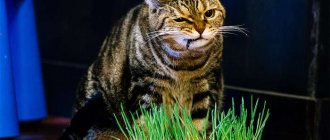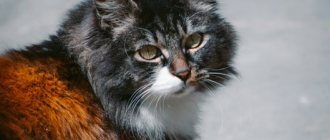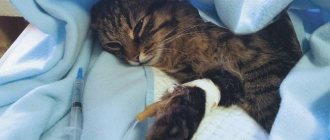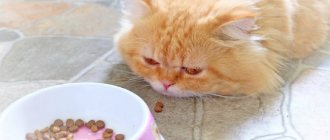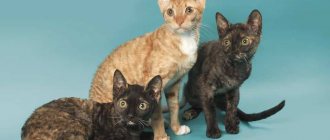Domestic cats, like their wild relatives, are true predators. To maintain normal metabolism, health and quality of life, they need animal proteins. Even the laziest pets happily hunt and eat the caught prey. However, despite the fact that the animals are absolute meat eaters, sometimes they are not averse to nibbling on herbaceous plants. If they do not have access to the street, indoor flowers suffer from sharp teeth. Grass for cats plays the role of an important nutritional and medicinal component.
Why do cats eat grass?
If you notice your cat eating grass on a walk, there is no need to forbid her to do so.
There are several reasons why the mustache needs greens:
- Stomach cleansing. There are almost no coarse fibers in the animal food of the main diet, but they are present in large quantities in plant foods. As they pass through the digestive system, they clean the walls of the esophagus and intestines from food debris and pieces of hair that have stuck to the walls of the esophagus. And the most important benefit is that the herb removes toxins from the body through regurgitation.
- Improved bowel function. Some herbs have a laxative or fixative effect. Cats have preferences and some knowledge about herbs, which are determined at the genetic level. To relax the intestines, the cat will eat broad-leaved plants, and to strengthen the intestines, narrow-leaved plants.
- Diet expansion. Various greens contain many valuable macro- and microelements, vitamins and amino acids. When a cat gives birth to kittens, she chooses plants that contain folic acid. It allows you to better saturate the animal’s blood with oxygen, which has a positive effect on the development of the offspring.
- Self-medication. Scientists still adhere to this version. But when examining many cats that regularly eat greens, veterinarians did not find any significant diseases or disorders of the body.
- Taste preferences. Sometimes the pet does not swallow the plant, but only slightly bites it; from this behavior we can safely conclude that they simply like its taste.
Anxiety
Like humans, cats are susceptible to what is called “stress eating” or “emotional eating,” which causes the animal to eat not to relieve crippling hunger, but to relieve anxiety or satisfy an oral fixation.
If a cat is stressed, it has a need to get rid of the emotional tension that has arisen. A pet who constantly eats grass or plants may be under constant stress.
What greens do cats eat?
Walking outside on a sunny day, cats do not eat all the vegetation in a row, but only plants with thin and narrow leaves.
The most delicious green cat food is wild-growing herbaceous cereals.
These include:
- Wheatgrass;
- Sedge;
- Wild oats;
- bentgrass;
- Timofeevka and others.
What plants can cause the death of an animal?
Dangerous and even deadly plants that kitties are prohibited from eating include:
- geranium;
- calendula;
- aloe;
- Melissa;
- peppermint;
- lily.
In fact, the list of dangerous plants is very long. Therefore, before buying a new indoor plant, you need to make sure that it will not be dangerous for the cat. Of course, a kitty is unlikely to eat a toxic plant. But this risk cannot be excluded either.
What grass don't cats like?
Having a keen sense of smell, cats absolutely cannot tolerate vegetation that contains a lot of essential oils. Some of this vegetation is poisonous to purrs and can cause severe poisoning, for example, hyacinths or geraniums.
Field herbs that cats don't like:
- Melissa;
- Lavender;
- Sagebrush;
- Tansy.
Cats try to stay away from such plants. Owners often use such plants to wean cats from some unwanted actions. For example, when a cat scratches on furniture or shits in the corners of the room.
What should you do if your cat vomits after eating plants?
First of all, you need to understand why the cat is vomiting. In the wild, animals clear hairballs from their stomachs by vomiting. The green growth stimulates the urge to vomit, accelerating the process of release. In cats, like small predators, the body works according to the same scheme. Therefore, periodic vomiting after eating weed is normal.
The following symptoms may indicate that your cat is poisoned:
- complete refusal to eat;
- constant vomiting;
- lethargy, apathy, lack of playfulness, sweat;
- plaintive "crying";
- belly hard to the touch;
- desire to hide in a dark place.
In this situation, vomiting is not normal. You need to urgently take your kitty to a veterinarian.
Another reason to contact a veterinarian is that your cat eats green grass every day. This indicates digestive problems and even intestinal obstruction. If the cat refuses to eat, vomits blood, and the feces are colored black, it is necessary to urgently take the pet to the clinic.
How to grow grass for cats
Planting in vermiculite. You can buy vermiculite at any hardware or flower shop. This mineral is characterized by the fact that it retains moisture well; it also contains potassium, magnesium, ammonium and calcium, which are so necessary for any vegetation.
How to grow grass for a cat:
- The first step is to germinate the seeds. To do this, take a small part of vermiculite and fill it with warm water, then mix the mixture with the seeds, in this state the seeds should be left for 3 hours in a warm place.
- Next, you need to pour out the excess liquid and pour the mixture into any cup.
- It should be covered with cling film in order to obtain a greenhouse effect. Place in a warm place where the temperature is approximately 25-30 degrees Celsius.
- As soon as the first shoots appear, the film must be removed.
- After 5-7 days, you can treat your pet to delicious greens.
- Every 5 days you need to pour water into a cup, let it stand for 5 minutes, drain off the excess. This time is enough for the vermiculite to absorb the liquid and then gradually release it to the roots.
You cannot grow greens more than 25-30 centimeters, as then they begin to accumulate toxins that are harmful to all pets.
Cats do a lot of strange things, and one of them is eating grass. Why do domestic predators need this atypical component of their diet, what grass is good for cats, and what to do if a cat gets into the habit of eating indoor flowers? Let's answer in order.
Cat detox
Why do cats eat grass? Most cat owners believe that animals thus compensate for vitamin deficiencies.
Indeed, fresh greens contain folic acid, which regulates metabolism and increases the level of red blood cells in the blood. But bad luck, the gastrointestinal tract of cats is not adapted to absorb this substance from grass, because our pets are predators, not herbivores.
Then why do cats eat blades of grass? What is the reason for this strange behavior - a bad habit? No and no again. Scientists say that this is a natural physiological need.
In nature, cats eat small birds and rodents, and they eat their prey whole, with feathers, skins and bones. However, the cat's stomach is not able to digest these components, and the cat regurgitates the undigested remains along with gastric juice.
To facilitate this process, grass is required. Blades of grass irritate the gastric mucosa and stimulate regurgitation. Likewise, the grass helps get rid of hair that cats accidentally swallow when licking.
In addition, chewing grass blades stimulates the activity of the muscles of the digestive tract and thereby helps get rid of intestinal parasites. Therefore, even pets that do not have to hunt for food retain the habit of eating blades of grass.
The herb eaten can act not only as a laxative, but also eliminate intestinal upset. Researchers have noticed that cats choose different types of grass depending on their body's needs. They eat plants with wide stems as a laxative, and chew greens with narrow stems to combat diarrhea.
Do cats always eat grass only for utilitarian reasons?
It turns out not. There are pets that do not swallow greens, but only bite into the juicy stems. Apparently, they do this solely because they like the taste of the secreted plant juice. What to do if a cat eats indoor flowers?
If your furry pet gets into the habit of raiding indoor plants, wean her off this bad habit. Place fresh citrus peels in the pot often - cats cannot stand their strong smell. Another way is to spray the leaves with water generously flavored with hot pepper powder.
Also, be sure to offer the animal an alternative. If tasty chlorophytum and garden seedlings are banned, the cat should still have greens that she can chew with complete impunity.
What grass should I plant for my cat?
Any pet store sells grass for cats, ready-made in plastic trays or in the form of seeds for germination. Blends usually include grains, sometimes with catnip.
You can also buy seeds for germination at gardening stores. A surefire option is oats, barley and wheat, in a mixture or separately.
In addition to seeds, to grow grass you will need:
- soil mixture (vermiculite or packaged light soil for flower plants) or gauze;
- container for planting (shallow flower pot, container or even a soup plate);
- polyethylene film to create a greenhouse effect.
Further steps vary depending on how you are going to germinate the seeds - in soil, in vermiculite or on gauze.
When germinating in normal soil:
- Wash the seeds and soak them for an hour.
- Empty most of the soil into the container.
- Spread the seeds evenly on the soil base.
- Sprinkle the rest of the soil mixture on top in a thin layer.
- Water the ground.
When germinated in vermiculite:
- Pour the mixture with cool water and leave for about an hour.
- Drain the water and pour the mixture into a sprouting container.
- Sprinkle with water.
When germinating on gauze:
- Rinse and soak the seeds in cool water.
- Drain the water and place gauze at the bottom of the container.
- Sprinkle the seeds evenly on top and cover with another piece of gauze.
- Sprinkle with water.
Regardless of the germination method, stretch plastic film over the container to create a greenhouse effect - then the seeds will germinate faster.
Now all that remains is to put the mini-garden in a warm place (for example, on a radiator). On the second or third day, the seeds will germinate, but do not rush to remove the film - let the young shoots stretch out properly.
Around the sixth to eighth day of green, the cat's treat will be ready. Remove the plastic and let your pet try young, juicy grass.
When a cat eats grass, it will definitely vomit. Don't be alarmed, this process is absolutely physiological. The only thing that doesn’t hurt is to make sure that the pet cleans its stomach away from the carpet or sofa.
Petstory app - an online assistant for cat owners
Keep in mind that many indoor and garden flowers are poisonous to cats. Their list includes violets, geraniums, calendula, lily of the valley, chrysanthemums and all bulbous flowers. If you decide to get a kitten, you should refrain from breeding them.
What if the cat did eat a violet or oleander? Install the Petstory app on your smartphone in advance, and then in an alarming situation you can almost instantly consult an experienced veterinarian. Within a few minutes, a specialist will answer you whether there is any point in worrying and what to do next.
In addition, the service provides the ability to remotely register with veterinary clinics in your city. Comparing the cost of admission in different institutions allows you to choose the best price.
The application also provides an interactive map indicating the addresses and contact details of pet stores. Thanks to it, you will quickly find out where you can buy cat grass and other necessary things for pets near you.
Download the specialized application for pet owners Petstory on the IOS and Android platforms using the link – https://petstory.ru/prilozhenie-konsultacija-veterinar/.
As an advertisement
Growing in the ground
You can also grow grass for your favorite purr in a flower pot with regular soil. Before planting seeds, you should thoroughly disinfect the soil - heat it with a gas burner (laying it on the ground), this is the most accessible and effective way. But you can also moisten the soil with a weak solution of potassium permanganate (potassium permanganate).
Instructions for growing grass in the ground:
- Soak the seeds in warm boiled water in a plastic container for 10 hours for germination.
- Lay 3-4 centimeters of disinfected soil without debris, place the seeds on top with the roots down.
- They should be covered with a 0.5 cm layer of soil on top.
- After germination, you will need to water the grass every 3 days.
If the seeds have been lying around for a long time, then it is better to germinate them under cling film, where a greenhouse effect is created, then the results will be much better.
Which seeds to choose
As has already become known, not every grass is suitable for planting. It is best to choose the seeds of oats, wheat, barley and other cereal plants at the pet store. And if you are not sure that this particular herb will help your pet, choose complex preparations, because the market does not stand still and is constantly evolving.
Different cats eat different grass
And yet, what is the best grass to plant for a cat at home? Now we will look at several options that pet stores offer us:
| Name | Compound | Growing methods |
| Alpine meadows 7 herbs | Oats, wheat, rye, barley, millet, sorghum, vetch; | Herbs in a vermiculite-based substrate. The kit comes with a container, pour out the substance, moisten it with water, lay out the seeds, cover the container with a lid. Place in a warm, bright place. The grass grows in approximately 10 days. |
| Horse | Oats, ryegrass, meadow grass; | Seeds can be germinated in any way convenient for you. Approximate growing time is one and a half to two weeks. Grass height 10 cm. |
| Weed for cats TitBit | Oats | This product is very easy to use, as it comes with a container and a padding polyester bag. You just need to pour water on it, cover it with a lid and place it in a warm, lighted place. After 8-10 days, your cat can enjoy fresh grass. |
If the cat doesn't eat grass
It may happen that all the owner’s efforts to grow greens for his furry pet will be in vain. In this case, the cat should be accustomed to greens without haste, sometimes adding them to food.
If the cat is interested in this, then in the future he will begin to eat the vegetation. If this method does not work, try sometimes offering grass to your cat, and maybe one day he will appreciate such care.
- If your pet doesn’t want to eat grass at all, you don’t need to force him.
- But if the cat, on the contrary, is very interested in devouring various types of vegetation, then there is a good reason to take him to an appointment with a veterinarian.
- Perhaps the animal has health problems that need attention.
We are sure that this article was useful for you, do not be lazy to grow a green treat for your pet yourself. She will definitely appreciate it!
Are herbs always beneficial?
Cats living in nature or on the street usually instinctively choose the right herbs for medicinal or cleansing purposes. Pets do not have this experience, and their instincts are most often somewhat muted. There is a high risk for them to chew grass that is hazardous to their health while walking.
Even a plant that is safe in its composition can cause considerable harm if it grows in a polluted area - on roadsides or near industrial enterprises. In addition, there is no guarantee that this grass is not contaminated with helminth eggs or contaminated by the feces of a sick animal.
Not all outdoor grass is good for your pet.
If the animal does not leave the house and does not receive the necessary greenery in the required quantities, then it may well switch to nibbling indoor plants, some of which may be very poisonous. As a result - various troubles, even death, and specifically the following side effects:
- uncontrollable vomiting;
- digestive disorders;
- pain and cramps;
- renal, heart or pulmonary failure.
Common houseplants can cause serious harm to a cat.
Here are some houseplants to keep out of your cat's reach:
- amaralis;
- asparagus;
- geranium;
- dieffenbachia;
- caladium;
- lily of the valley;
- spurge;
- narcissus;
- oleander;
- ivy;
- spathiphyllum;
- physalis;
- ficus;
- philodendron;
- Cyperus;
- cyclamen.
Offer your pet only safe green treats.
Video: which plants can be dangerous for a cat
"Vegetable garden" for a cat
Some caring owners regularly collect fresh grass for their pets on the street and even dry it for the winter. But the benefits of such care are very doubtful. If you are not completely sure that a vitamin supplement will be harmless for your pets, it is better to grow the greens yourself, especially since it is absolutely not difficult.
Cat grass should only be collected in clean and safe places.
What grass to grow
At home, the easiest way to germinate grains of cereal plants is: wheat, oats and barley - they are distinguished by good germination and rapid development, and cats really like their juicy sprouts.
Cereal seeds are good for growing cat grass
There are a lot of useful substances in such greens, and there will definitely be no harm from them - but only if you are guaranteed to purchase seeds that have not been treated with pesticides to protect them from rodents. To play it safe, buy planting material from pet stores.
Carrot tops grown on a windowsill are a storehouse of vitamins for your cat
Of course, you can experiment and proceed from your pet’s preferences - offer him sprouts of various plants, thereby enriching the cat’s diet. But this requires certain knowledge and experience in order to choose the right “bouquet” of herbs and get a good harvest of greens.
